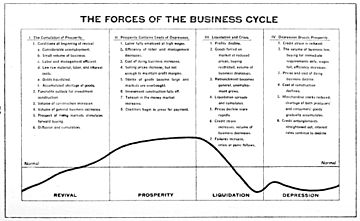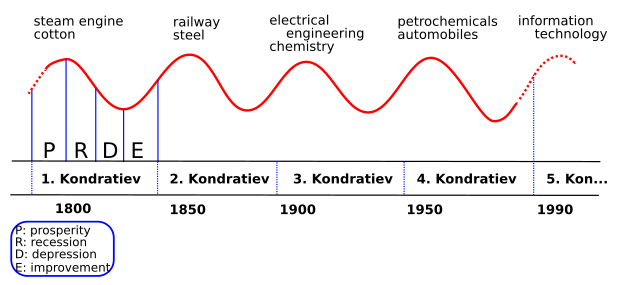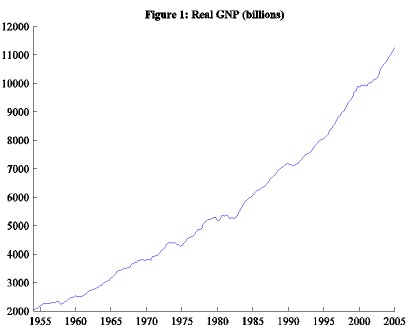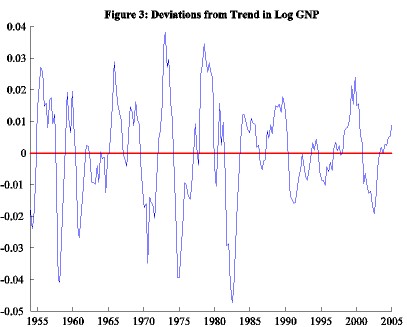Business cycle facts for kids
Business cycles are intervals of expansion followed by recession in economic activity. A recession is sometimes technically defined as 2 quarters of negative GDP growth, but definitions vary; for example, in the United States, a recession is defined as "a significant decline in economic activity spread across the market, lasting more than a few months, normally visible in real GDP, real income, employment, industrial production, and wholesale-retail sales." The changes in economic activity that characterize business cycles have implications for the welfare of the broad population as well as for private institutions. Typically business cycles are measured by examining trends in a broad economic indicator such as Real Gross Domestic Production.
Business cycle fluctuations are usually characterized by general upswings and downturns in a span of macroeconomic variables. The individual episodes of expansion/recession occur with changing duration and intensity over time. Typically their periodicity has a wide range from around 2 to 10 years. The technical term "stochastic cycle" is often used in statistics to describe this kind of process. Such flexible knowledge about the frequency of business cycles can actually be included in their mathematical study, using a Bayesian statistical paradigm.
There are numerous sources of business cycle movements such as rapid and significant changes in the price of oil or variation in consumer sentiment that affects overall spending in the macroeconomy and thus investment and firms' profits. Usually such sources are unpredictable in advance and can be viewed as random "shocks" to the cyclical pattern, as happened during the 2007–2008 financial crises or the COVID-19 pandemic. In past decades economists and statisticians have learned a great deal about business cycle fluctuations by researching the topic from various perspectives. Examples of methods that learn about business cycles from data include the Christiano–Fitzgerald, Hodrick–Prescott, and singular spectrum filters.
Contents
History
Theory
The first systematic exposition of economic crises, in opposition to the existing theory of economic equilibrium, was the 1819 Nouveaux Principes d'économie politique by Jean Charles Léonard de Sismondi. Prior to that point classical economics had either denied the existence of business cycles, blamed them on external factors, notably war, or only studied the long term. Sismondi found vindication in the Panic of 1825, which was the first unarguably international economic crisis, occurring in peacetime.
Sismondi and his contemporary Robert Owen, who expressed similar but less systematic thoughts in 1817 Report to the Committee of the Association for the Relief of the Manufacturing Poor, both identified the cause of economic cycles as overproduction and underconsumption, caused in particular by wealth inequality. They advocated government intervention and socialism, respectively, as the solution. This work did not generate interest among classical economists, though underconsumption theory developed as a heterodox branch in economics until being systematized in Keynesian economics in the 1930s.
Sismondi's theory of periodic crises was developed into a theory of alternating cycles by Charles Dunoyer, and similar theories, showing signs of influence by Sismondi, were developed by Johann Karl Rodbertus. Periodic crises in capitalism formed the basis of the theory of Karl Marx, who further claimed that these crises were increasing in severity and, on the basis of which, he predicted a communist revolution. Though only passing references in Das Kapital (1867) refer to crises, they were extensively discussed in Marx's posthumously published books, particularly in Theories of Surplus Value. In Progress and Poverty (1879), Henry George focused on land's role in crises – particularly land speculation – and proposed a single tax on land as a solution.
Statistical or econometric modelling and theory of business cycle movements can also be used. In this case a time series analysis is used to capture the regularities and the stochastic signals and noise in economic time series such as Real GDP or Investment. [Harvey and Trimbur, 2003, Review of Economics and Statistics] developed models for describing stochastic or pseudo- cycles, of which business cycles represent a leading case. As well-formed and compact – and easy to implement – statistical methods may outperform macroeconomic approaches in numerous cases, they provide a solid alternative even for rather complex economic theory.
Classification by periods
In 1860 French economist Clément Juglar first identified economic cycles 7 to 11 years long, although he cautiously did not claim any rigid regularity. This interval of periodicity is also commonplace, as an empirical finding, in time series models for stochastic cycles in economic data. Furthermore, methods like statistical modelling in a Bayesian framework – see e.g. [Harvey, Trimbur, and van Dijk, 2007, Journal of Econometrics] – can incorporate such a range explicitly by setting up priors that concentrate around say 6 to 12 years, such flexible knowledge about the frequency of business cycles can actually be included in their mathematical study, using a Bayesian statistical paradigm.
Later, economist Joseph Schumpeter argued that a Juglar cycle has four stages:
- Expansion (increase in production and prices, low interest rates)
- Crisis (stock exchanges crash and multiple bankruptcies of firms occur)
- Recession (drops in prices and in output, high interest-rates)
- Recovery (stocks recover because of the fall in prices and incomes)
Schumpeter's Juglar model associates recovery and prosperity with increases in productivity, consumer confidence, aggregate demand, and prices.
In the 20th century, Schumpeter and others proposed a typology of business cycles according to their periodicity, so that a number of particular cycles were named after their discoverers or proposers:
| Cycle/wave name | Period (years) |
|---|---|
| Kitchin cycle (inventory, e.g. pork cycle) | 3–5 |
| Juglar cycle (fixed investment) | 7–11 |
| Kuznets swing (infrastructural investment) | 15–25 |
| Kondratiev wave (technological basis) | 45–60 |
- The Kitchin inventory cycle of 3 to 5 years (after Joseph Kitchin)
- The Juglar fixed-investment cycle of 7 to 11 years (often identified as "the" business cycle). A range of periods rather than one fixed period is needed to capture business cycle fluctuations, which may be done by using a random or irregular source as in an econometric or statistical framework.
- The Kuznets infrastructural investment cycle of 15 to 25 years (after Simon Kuznets – also called "building cycle")
- The Kondratiev wave or long technological cycle of 45 to 60 years (after the Soviet economist Nikolai Kondratiev)
Some say interest in the different typologies of cycles has waned since the development of modern macroeconomics, which gives little support to the idea of regular periodic cycles. Further econometric studies such as the two works in 2003 and 2007 cited above demonstrate a clear tendency for cyclical components in macroeconomic times to behave in a stochastic rather than deterministic way.
Others, such as Dmitry Orlov, argue that simple compound interest mandates the cycling of monetary systems. Since 1960, World GDP has increased by fifty-nine times, and these multiples have not even kept up with annual inflation over the same period. Social Contract (freedoms and absence of social problems) collapses may be observed in nations where incomes are not kept in balance with cost-of-living over the timeline of the monetary system cycle.
The Bible (760 BCE) and Hammurabi's Code (1763 BCE) both explain economic remediations for cyclic sixty-year recurring great depressions, via fiftieth-year Jubilee (biblical) debt and wealth resets. Thirty major debt forgiveness events are recorded in history including the debt forgiveness given to most European nations in the 1930s to 1954.
Occurrence
There were great increases in productivity, industrial production and real per capita product throughout the period from 1870 to 1890 that included the Long Depression and two other recessions. There were also significant increases in productivity in the years leading up to the Great Depression. Both the Long and Great Depressions were characterized by overcapacity and market saturation.
Over the period since the Industrial Revolution, technological progress has had a much larger effect on the economy than any fluctuations in credit or debt, the primary exception being the Great Depression, which caused a multi-year steep economic decline. The effect of technological progress can be seen by the purchasing power of an average hour's work, which has grown from $3 in 1900 to $22 in 1990, measured in 2010 dollars. There were similar increases in real wages during the 19th century. (See: Productivity improving technologies (historical).) A table of innovations and long cycles can be seen at: Business cycle § Notes. Since surprising news in the economy, which has a random aspect, impact the state of the business cycle, any corresponding descriptions must have a random part at its root that motivates the use of statistical frameworks in this area.
There were frequent crises in Europe and America in the 19th and first half of the 20th century, specifically the period 1815–1939. This period started from the end of the Napoleonic wars in 1815, which was immediately followed by the Post-Napoleonic depression in the United Kingdom (1815–1830), and culminated in the Great Depression of 1929–1939, which led into World War II. See Financial crisis: 19th century for listing and details. The first of these crises not associated with a war was the Panic of 1825.
Business cycles in OECD countries after World War II were generally more restrained than the earlier business cycles. This was particularly true during the Golden Age of Capitalism (1945/50–1970s), and the period 1945–2008 did not experience a global downturn until the Late-2000s recession. Economic stabilization policy using fiscal policy and monetary policy appeared to have dampened the worst excesses of business cycles, and automatic stabilization due to the aspects of the government's budget also helped mitigate the cycle even without conscious action by policy-makers.
In this period, the economic cycle – at least the problem of depressions – was twice declared dead. The first declaration was in the late 1960s, when the Phillips curve was seen as being able to steer the economy. However, this was followed by stagflation in the 1970s, which discredited the theory. The second declaration was in the early 2000s, following the stability and growth in the 1980s and 1990s in what came to be known as the Great Moderation. Notably, in 2003, Robert Lucas, in his presidential address to the American Economic Association, declared that the "central problem of depression-prevention [has] been solved, for all practical purposes." This was followed by the 2008–2012 global recession.
Various regions have experienced prolonged depressions, most dramatically the economic crisis in former Eastern Bloc countries following the end of the Soviet Union in 1991. For several of these countries the period 1989–2010 has been an ongoing depression, with real income still lower than in 1989. This has been attributed not to a cyclical pattern, but to a mismanaged transition from command economies to market economies.
Identifying
In 1946, economists Arthur F. Burns and Wesley C. Mitchell provided the now standard definition of business cycles in their book Measuring Business Cycles:
Business cycles are a type of fluctuation found in the aggregate economic activity of nations that organize their work mainly in business enterprises: a cycle consists of expansions occurring at about the same time in many economic activities, followed by similarly general recessions, contractions, and revivals which merge into the expansion phase of the next cycle; in duration, business cycles vary from more than one year to ten or twelve years; they are not divisible into shorter cycles of similar characteristics with amplitudes approximating their own.
According to A. F. Burns:
Business cycles are not merely fluctuations in aggregate economic activity. The critical feature that distinguishes them from the commercial convulsions of earlier centuries or from the seasonal and other short term variations of our own age is that the fluctuations are widely diffused over the economy – its industry, its commercial dealings, and its tangles of finance. The economy of the western world is a system of closely interrelated parts. He who would understand business cycles must master the workings of an economic system organized largely in a network of free enterprises searching for profit. The problem of how business cycles come about is therefore inseparable from the problem of how a capitalist economy functions.
In the United States, it is generally accepted that the National Bureau of Economic Research (NBER) is the final arbiter of the dates of the peaks and troughs of the business cycle. An expansion is the period from a trough to a peak and a recession as the period from a peak to a trough. The NBER identifies a recession as "a significant decline in economic activity spread across the economy, lasting more than a few months, normally visible in real GDP, real income, employment, industrial production".
Upper turning points of business cycle, commodity prices and freight rates
There is often a close timing relationship between the upper turning points of the business cycle, commodity prices, and freight rates, which is shown to be particularly tight in the grand peak years of 1873, 1889, 1900 and 1912. Hamilton expressed that in the post war era, a majority of recessions are connected to an increase in oil price.
Commodity price shocks are considered to be a significant driving force of the US business cycle.
Along these lines, the research in [Trimbur, 2010, International Journal of Forecasting] shows empirical results for the relation between oil-prices and real GDP. The methodology uses a statistical model that incorporate level shifts in the price of crude oil; hence the approach describes the possibility of oil price shocks and forecasts the likelihood of such events.
Indicators
Economic indicators are used to measure the business cycle: consumer confidence index, retail trade index, unemployment and industry/service production index. Stock and Watson claim that financial indicators' predictive ability is not stable over different time periods because of economic shocks, random fluctuations and development in financial systems. Ludvigson believes consumer confidence index is a coincident indicator as it relates to consumer's current situations. Winton & Ralph state that retail trade index is a benchmark for the current economic level because its aggregate value counts up for two-thirds of the overall GDP and reflects the real state of the economy. According to Stock and Watson, unemployment claim can predict when the business cycle is entering a downward phase. Banbura and Rüstler argue that industry production's GDP information can be delayed as it measures real activity with real number, but it provides an accurate prediction of GDP.
Series used to infer the underlying business cycle fall into three categories: lagging, coincident, and leading. They are described as main elements of an analytic system to forecast peaks and troughs in the business cycle. For almost 30 years, these economic data series are considered as "the leading index" or "the leading indicators"-were compiled and published by the U.S. Department of Commerce.
A prominent coincident, or real-time, business cycle indicator is the Aruoba-Diebold-Scotti Index.
See also
 In Spanish: Ciclo económico para niños
In Spanish: Ciclo económico para niños







